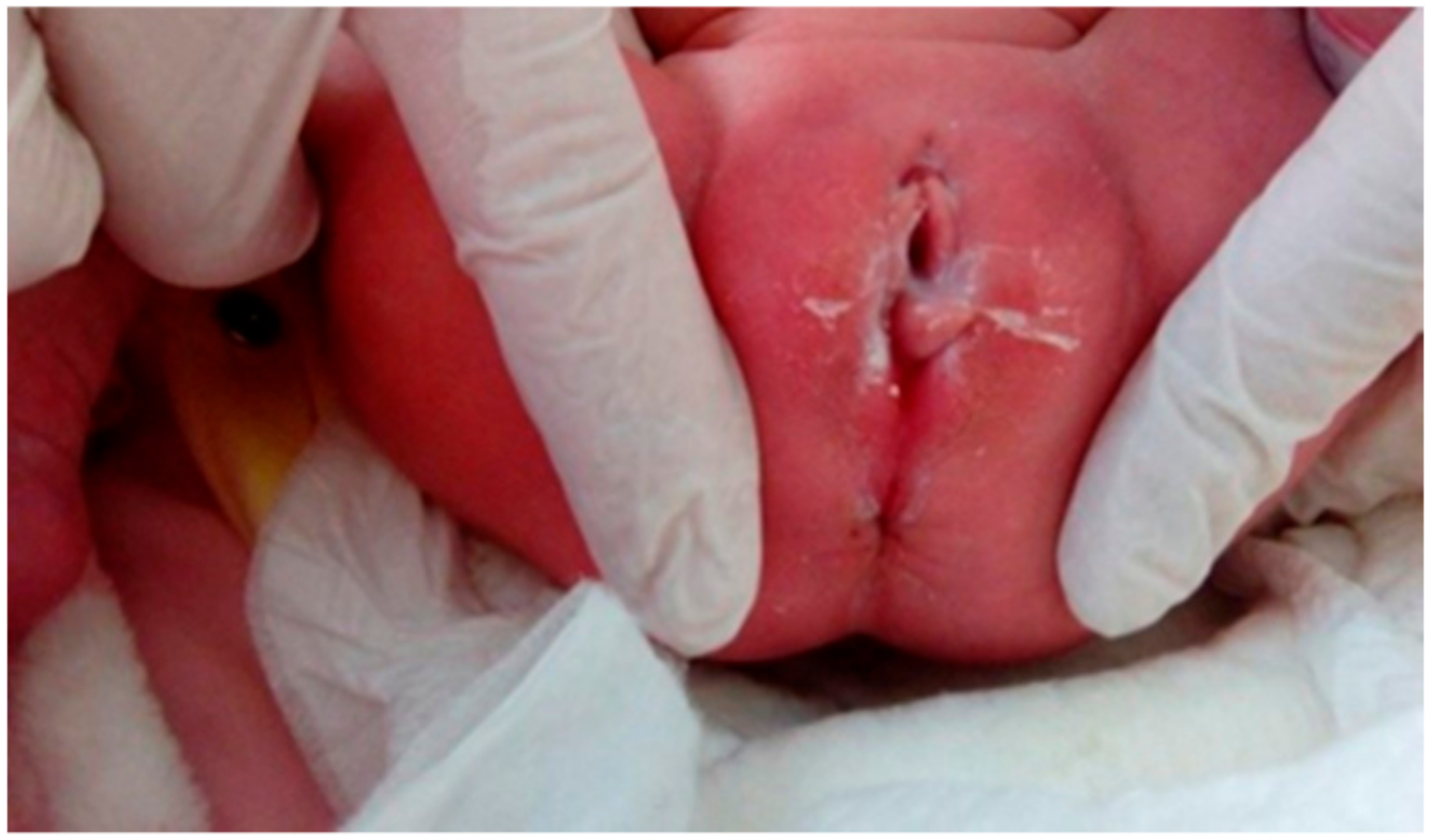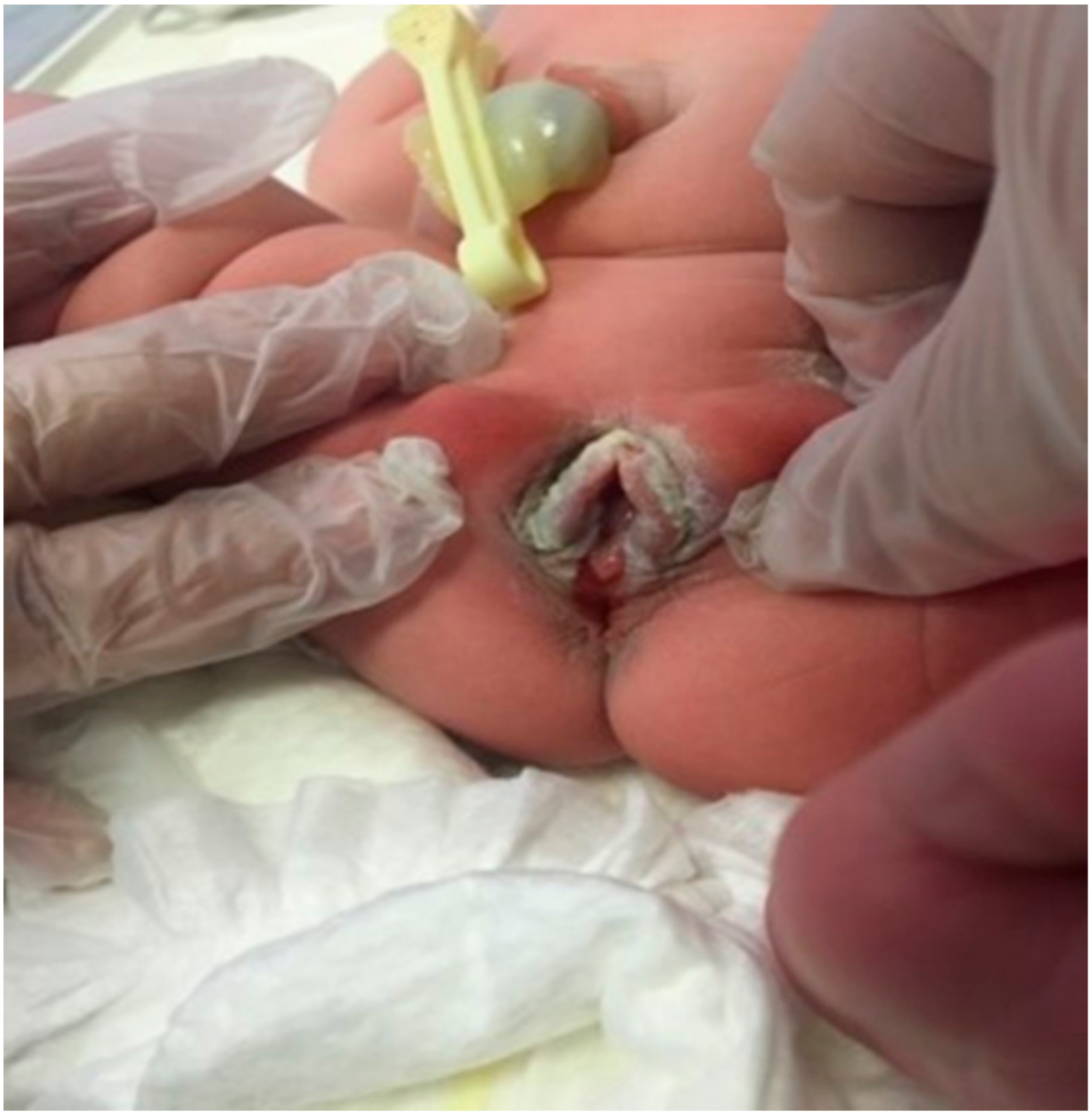Four Cases of Perineal Groove—Experience of a Greek Maternity Hospital
Abstract
:1. Introduction
2. Cases Presentation
2.1. Case 1
2.2. Case 2
2.3. Case 3
2.4. Case 4
3. Discussion
4. Conclusions
Acknowledgments
Conflicts of Interest
References
- Harsono, M.; Pourcyrous, M. Perineal groove: A rare congenital midline defect of perineum. Am. J. Perinatol. Rep. 2016, 6, e30–e32. [Google Scholar]
- Diaz, L.; Levy, M.L.; Kalajian, A.; Metry, D. Perineal groove: A report of 2 cases. JAMA Dermatol. 2014, 150, 101–102. [Google Scholar] [CrossRef] [PubMed]
- Stephens, F.D. The female anus, perineum and vestibule: Embryogenesis and deformities. Aust. NZJ Obstet. Gynaec. 1968, 8, 55–73. [Google Scholar] [CrossRef]
- Esposito, C.; Giurin, I.; Savanelli, A.; Alicchio, F.; Settimi, A. Current trends in the management of pediatric patients with perineal groove. J. Pediatr. Adolesc. Gynecol. 2011, 24, 263e–265e. [Google Scholar] [CrossRef] [PubMed]
- Siruguppa, K.; Tuli, S.S.; Kelly, M.N.; Tuli, S.Y. Newborn female with a midline perineal defect. Clin. Pediatr. 2012, 51, 188–190. [Google Scholar] [CrossRef] [PubMed]
- Kluth, D. Embryology of anorectal malformations. Semin. Pediatr. Surg. 2010, 19, 201–208. [Google Scholar] [CrossRef] [PubMed]
- Verma, S.B.; Wollina, U. Perineal groove—A case report. Pediatr. Dermatol. 2010, 27, 626–627. [Google Scholar] [CrossRef] [PubMed]
- Sekaran, P.; Shawis, R. Perineal groove: A rare congenital abnormality of failure of fusion of the perineal raphe and discussion of its embryological origin. Clin. Anat. 2009, 22, 823–825. [Google Scholar] [CrossRef] [PubMed]





© 2019 by the authors. Licensee MDPI, Basel, Switzerland. This article is an open access article distributed under the terms and conditions of the Creative Commons Attribution (CC BY) license (http://creativecommons.org/licenses/by/4.0/).
Share and Cite
Boutsikou, T.; Mougiou, V.; Sokou, R.; Kollia, M.; Kafalidis, G.; Iliodromiti, Z.; Salakos, C.; Iacovidou, N. Four Cases of Perineal Groove—Experience of a Greek Maternity Hospital. Medicina 2019, 55, 488. https://doi.org/10.3390/medicina55080488
Boutsikou T, Mougiou V, Sokou R, Kollia M, Kafalidis G, Iliodromiti Z, Salakos C, Iacovidou N. Four Cases of Perineal Groove—Experience of a Greek Maternity Hospital. Medicina. 2019; 55(8):488. https://doi.org/10.3390/medicina55080488
Chicago/Turabian StyleBoutsikou, Theodora, Vasiliki Mougiou, Rozeta Sokou, Maria Kollia, George Kafalidis, Zoi Iliodromiti, Christos Salakos, and Nicoletta Iacovidou. 2019. "Four Cases of Perineal Groove—Experience of a Greek Maternity Hospital" Medicina 55, no. 8: 488. https://doi.org/10.3390/medicina55080488





